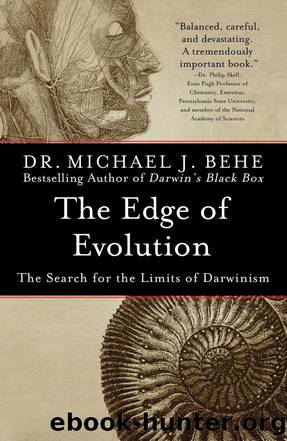The Edge of Evolution by Michael J. Behe

Author:Michael J. Behe [Behe, Michael J.]
Language: eng
Format: mobi
Publisher: Simon & Schuster, Inc.
Published: 2007-06-04T23:00:00+00:00
9
THE CATHEDRAL AND THE SPANDRELS
HOW DEEP GOES DESIGN?
Up until now we have examined molecular structures and processes and have drawn a tentative line marking the molecular edge of Darwinian evolution. Most protein-protein interactions in the cell are not due to random mutation. Since cells are integrated units, itâs reasonable to view cells in their entirety as designed. But keep in mind that accidents do happen, so there are Darwinian effects, of some degree, everywhere. For example, just as automobiles may accumulate dents or scratches over time, or have mufflers fall off, but nonetheless are coherent, designed systems, so, too, with cells. Some features of cells of course result from genetic dents or scratches or loss, but the cell as a whole, it seems, was designed.
Now itâs time to look at higher levels of biological organization. There are several major classes of cells, which include the simpler prokaryotic cells of bacteria and the more complex eukaryotic cells of creatures ranging from yeasts to humans. Were just the simpler, prokaryotic cells designed? Could the more complex eukaryotic cells have evolved from them over time by unintelligent processes? In other words, given the simpler, designed cells in the distant past as a starting point, is it biologically reasonable to think that random mutation and natural selection could reach the more complex cells?
No. Eukaryotic cells contain a raft of complex functional systems that the simpler prokaryotes lack, systems that are enormously beyond Darwinian processes. For example, the cilium discussed in Chapter 5, which contains hundreds of protein parts, and IFT, the system that constructs the cilium from the ground up, both appear in eukaryotic cells, but not in prokaryotic cells. And the cilium isnât the only difference. As the evolutionary developmental biologists Marc Kirschner and John Gerhart exclaim in The Plausibility of Life, âenormous innovations attended the evolution of the first single-celled eukaryotes one and a half to two billion years ago.â1 The innovations include such fundamental features as sexual reproduction (meiosis and recombination), the organization of DNA into chromatin, and the provisioning of a cellular protein âskeleton.â Of course, the two kinds of cells share a number of similar systems, such as the genetic code. Nonetheless, just as itâs reasonable to view a motorcycle as a different sort of system from a bicycle, because eukaryotic cells contain multiple complex systems that prokaryotes do not, itâs reasonable to view eukaryotes as integrated, designed systems in their own right,
So design extends beyond the simplest cells at least to more complex cells, which is the biological level of âkingdom.â Does it go further? Although prokaryotes are single-celled organisms, not all eukaryotes are. Eukaryotes include not only single-celled organisms such as yeast and malaria, but also multicellular organisms: plants, and animals from jellyfish to insects to humans. So does design stop at the eukaryotic cell, or does it extend to multicellular organisms? More pointedly, given a generic, designed, eukaryotic cell in the distant past, is it biologically reasonable to think that over time the rest of life developed from it entirely by unintelligent processes? This chapter answers that question.
Download
This site does not store any files on its server. We only index and link to content provided by other sites. Please contact the content providers to delete copyright contents if any and email us, we'll remove relevant links or contents immediately.
| Africa | Americas |
| Arctic & Antarctica | Asia |
| Australia & Oceania | Europe |
| Middle East | Russia |
| United States | World |
| Ancient Civilizations | Military |
| Historical Study & Educational Resources |
The Daily Stoic by Holiday Ryan & Hanselman Stephen(2709)
The Fate of Rome: Climate, Disease, and the End of an Empire (The Princeton History of the Ancient World) by Kyle Harper(2436)
People of the Earth: An Introduction to World Prehistory by Dr. Brian Fagan & Nadia Durrani(2346)
Ancient Worlds by Michael Scott(2104)
Babylon's Ark by Lawrence Anthony(2070)
Foreign Devils on the Silk Road: The Search for the Lost Treasures of Central Asia by Peter Hopkirk(2056)
India's Ancient Past by R.S. Sharma(1988)
MOSES THE EGYPTIAN by Jan Assmann(1973)
The Complete Dead Sea Scrolls in English (7th Edition) (Penguin Classics) by Geza Vermes(1842)
Lost Technologies of Ancient Egypt by Christopher Dunn(1798)
The Daily Stoic by Ryan Holiday & Stephen Hanselman(1770)
The Earth Chronicles Handbook by Zecharia Sitchin(1744)
24 Hours in Ancient Rome by Philip Matyszak(1678)
Alexander the Great by Philip Freeman(1650)
Aztec by Gary Jennings(1545)
The Nine Waves of Creation by Carl Johan Calleman(1520)
Curse Tablets and Binding Spells from the Ancient World by Gager John G.;(1510)
Before Atlantis by Frank Joseph(1484)
Earthmare: The Lost Book of Wars by Cergat(1469)
